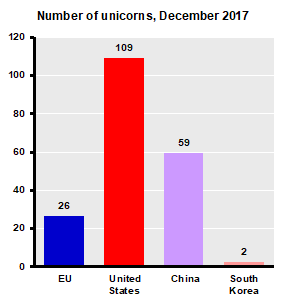The state of research and innovation in Europe in 7 charts

Brussels' Atomium building, a metal structure built in the form of a crystal of iron Image: REUTERS/Francois Lenoir
Román Arjona
Chief Economist, Directorate-General for Internal Market, Industry, Entrepreneurship and SMEs, European Commission
Get involved with our crowdsourced digital platform to deliver impact at scale
Stay up to date:
European Union
How does research and innovation in Europe compare to the rest of the world? The Science, Research and Innovation Performance of the EU 2018 (SRIP) Report suggests that while the continent is a leader in science, it is falling behind other regions in how it develops and invests in innovation. These seven charts help us to understand the state of play with science and innovation in Europe:
1. The effect of low productivity growth

Low productivity growth is preventing more robust growth in Europe. Despite the rise of several new technologies with the potential to bring large gains in productivity, such as the Internet of Things or artificial intelligence (AI), productivity growth has been sluggish owing to the slow diffusion of innovations.
2. A leader in science

Europe is a research powerhouse and a global leader in high quality science
3. A follower in entrepreneurship

Europe fails to transform leadership in science into leadership in innovation and entrepreneurship. None of the world’s top 15 companies by market capitalization are European and in December 2017 Europe had just 26 unicorns (private companies with a market valuation above $1 billion). In comparison, the US had 106 and China had 59.
4. Falling behind in business R&D

Business research and development in Europe significantly lags behind third countries. It accounts for 1.3% of Europe's GDP, while in the US, Japan and South Korea it rises to 2%, 2.6% and 3.3% respectively.
5. Outstripped in venture capital

The venture capital that is crucial to ensure innovation investment is five times higher in the US than in Europe
6. The role of universities

Universities in Europe need to modernize and become more entrepreneurial to support the innovations of the future. Just 15 unicorn founders have a European university as their alma mater compared with 146 who attended a US institution.
7. Zombie firms and poor distribution of resources

Persistent rigidities in how markets function affect the effective redistribution of resources towards more innovative and productive companies. In Greece, Italy and Spain, for example, 28%, 19% and 15.5% of all is sunk into “zombie firms” - companies that are unable to cover their interest payments for three consecutive years
For more on Science, Research and Innovation read this European Commission report: https://ec.europa.eu/info/research-and-innovation/strategy/policy-support/science-research-and-innovation-performance-eu-srip-report_en
Don't miss any update on this topic
Create a free account and access your personalized content collection with our latest publications and analyses.
License and Republishing
World Economic Forum articles may be republished in accordance with the Creative Commons Attribution-NonCommercial-NoDerivatives 4.0 International Public License, and in accordance with our Terms of Use.
The views expressed in this article are those of the author alone and not the World Economic Forum.
The Agenda Weekly
A weekly update of the most important issues driving the global agenda
You can unsubscribe at any time using the link in our emails. For more details, review our privacy policy.
More on European UnionSee all
Kimberley Botwright and Spencer Feingold
March 27, 2024
Simon Torkington
February 8, 2024
Mirek Dušek and Andrew Caruana Galizia
January 17, 2024







